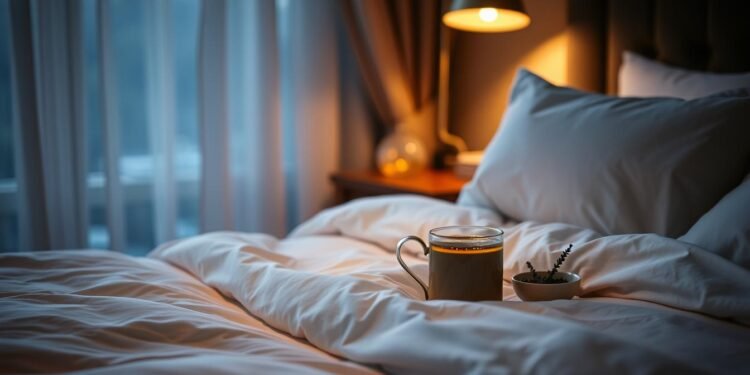Did you know that one-third of American adults struggle with insufficient sleep? It’s a widespread issue, with cities like Dallas ranking 38th in sleep metrics across the U.S. Poor sleep quality isn’t just a personal problem—it’s a public health concern recognized by the CDC.
Improving your sleep doesn’t have to feel overwhelming. Small, consistent changes to your bedtime routine can lead to significant improvements over time. By focusing on your environment, habits, and mindset, you can create a sustainable path to better rest.
This approach isn’t just about quick fixes. It’s about building a foundation for long-term sleep quality. Whether you’re in Dallas or elsewhere, these science-backed strategies can help you improve sleep and feel more refreshed every day.
Key Takeaways
- One-third of American adults lack adequate sleep, a public health issue.
- Dallas ranks 38th in sleep metrics among U.S. cities.
- Small daily adjustments can significantly improve sleep quality.
- A holistic approach combines environment, habits, and mindset.
- Consistency is key to achieving long-term results.
Why Sleep Hygiene Matters for Better Rest
Good sleep hygiene isn’t just a habit—it’s a necessity for a healthy brain and body. By prioritizing sleep hygiene, we can unlock the full potential of our circadian rhythm and improve overall health.
During deep sleep, growth hormones peak, aiding in tissue repair and cellular regeneration. This stage is crucial for maintaining weight management and preventing diseases. Meanwhile, REM cycles play a vital role in memory consolidation, helping us process and store information effectively.
Our brain, composed of 73% water, relies on hydration to function optimally. Morning water consumption can replenish fluids lost during sleep, enhancing cognitive performance. Additionally, nighttime heart rate reduction supports cardiovascular health, reducing the risk of heart-related issues.
Sleep deprivation has been linked to increased Alzheimer’s risk factors. Studies from the NIH highlight how proper sleep strengthens the immune system, while Harvard research emphasizes the importance of synchronizing our circadian rhythm for better rest.
Blue light from screens disrupts melatonin production, making it harder to fall asleep. By limiting screen time before bed, we can improve quality sleep. Remember, sleep debt accumulates over time, so consistency in our habits is key to long-term benefits.
What is a 30-Day Routine to Sleep Deeper?
Building better rest habits starts with a clear, science-backed plan. The National Sleep Foundation recommends 7-9 hours of rest for adults, but achieving this requires more than just time in bed. A structured approach focuses on four key phases: environment, routine, diet, and maintenance.
Neuroplasticity plays a crucial role in forming new habits. Research shows it takes about 21 days to establish a new behavior. By sticking to a consistent sleep schedule, we can train our brain to adapt more efficiently. This helps synchronize our circadian rhythm, the body’s internal clock.
Sleep cycles last 90-120 minutes, and body temperature drops 1-2°F during rest. Understanding these patterns can improve sleep efficiency. Tools like polysomnography measure sleep stages, providing insights into our rest quality.
Dr. Harris emphasizes the importance of consistency. Small, personalized adjustments can make a big difference. Tracking progress with printable PDF sheets or an alarm clock test ensures you’re on the right path. By focusing on these elements, we can create a sustainable plan for better rest.
Week 1: Setting the Foundation for Better Sleep
The first week of improving rest focuses on small, actionable changes to your environment and habits. These adjustments help create a solid foundation for long-term improvements in how you rest. By focusing on your surroundings and daily routines, you can set the stage for better rest quality.

Day 1: Visualize and Commit to Your Sleep Plan
Start by visualizing your goals for better rest. Guided visualization techniques can help you stay committed to your plan. Write down your intentions and keep them visible as a daily reminder.
Day 2: Observe and Document Current Sleep Habits
Track your current patterns using a sleep journal. Include time-stamped entries to identify trends. This step helps you understand what might be affecting your rest quality.
Day 3: Evaluate Sleep Surface and Pillows
Assess your mattress and pillows for comfort and support. Pressure mapping methods can help identify areas needing improvement. A well-aligned sleep surface reduces pressure points by 33%.
Day 4: Choose Right Sleep Attire
Opt for breathable fabrics like cotton to keep your body comfortable at night. Dr. Gaies recommends avoiding synthetic materials that can trap heat and disrupt rest.
Day 5: Adjust Sleep Position
Use physical therapist-approved alignment charts to find the best position for your body. Proper alignment supports spinal health and improves rest quality.
Day 6: Assess Mattress
Check your mattress firmness using a standardized scale. Most mattresses last 7-10 years, so consider replacing yours if it’s worn out. A mattress quiz can provide personalized recommendations.
Day 7: Wash/Change Bed Sheets
Follow CDC guidelines for bedding sanitation. Hypoallergenic sheets reduce allergen exposure by 47%, creating a cleaner, healthier sleep environment.
Week 2: Creating a Serene Sleep Environment
Creating a peaceful sleep environment can transform your nightly rest. This week, we’ll focus on optimizing your bedroom for better sleep quality. Small adjustments to your surroundings can make a big difference in how you rest.
Day 8: Optimize Bedroom for Sleep
Start by setting your bedroom temperature to 65°F, the ideal level for rest according to the NIH. Use a smart thermostat to maintain this temperature throughout the night. Adding a HEPA filter can improve air quality, reducing allergens that disrupt sleep.
Day 9: Reserve Bedroom for Sleep Only
Train your mind to associate the bedroom with rest by limiting activities to sleep only. Avoid working or watching TV in bed. This conditioning helps your hypothalamus signal it’s time to wind down.
Day 10: Start Sleep Diary
Track your sleep patterns using Dr. Harris’ sleep diary template. Document your bedtime, wake-up times, and any disturbances. This analysis helps identify habits affecting your rest.
Day 11: Set Consistent Sleep Schedule
Align your sleep schedule with your chronotype for better results. Consistency reinforces your circadian rhythm, making it easier to fall asleep and wake up naturally.
Day 12: Use Soothing Alarm
Replace jarring alarms with gradual wake-up systems. These mimic natural sunrise, gently signaling your mind to wake up. This approach reduces morning grogginess.
Day 13: Avoid Screens Before Bed
Limit exposure to blue light by using apps like F.lux or Night Shift. These tools adjust screen colors to warmer tones, reducing melatonin disruption. Aim to disconnect at least an hour before bedtime.
Day 14: Wash/Change Sheets Again
Follow a weekly laundry cycle to keep your bedding fresh. Hypoallergenic sheets reduce allergen exposure by 47%, creating a cleaner sleep environment. This simple step enhances comfort and hygiene.
Week 3: Incorporating Relaxation Techniques
Stress reduction methods are key to achieving deeper, more restorative rest. This week, we’ll focus on techniques that calm the mind and body, helping you fall asleep faster and stay asleep longer. By integrating these practices into your evening, you can create a more peaceful transition to night sleep.
Day 15: Take Hot Bath Before Bed
A 102°F bath before bed can increase slow-wave sleep by 13%. This thermal regulation technique helps your body cool down naturally, signaling it’s time to rest. Add a few drops of lavender essential oil for added relaxation benefits.
Day 16: Establish Bedtime Ritual
Create a calming bedtime ritual with Yoga Nidra guided scripts. This practice reduces stress and prepares your mind for rest. Consistency in your routine helps reinforce your body’s natural sleep signals.
Day 17: Plan for Night Wake-Ups
If you wake up during the night, use the cognitive shuffling technique. Focus on unrelated, mundane thoughts to distract your mind from stress. This method helps you fall back asleep faster.
Day 18: Keep Dream Journal
Recording your dreams can provide insights into your subconscious. It also helps identify any nightmare disorder red flags. Place your journal by your bed to make this a seamless part of your routine.
Day 19: Create To-Do List
Write down tomorrow’s tasks using bullet journaling methods. This practice clears your mind and reduces nighttime anxiety. Keep it simple and focused to avoid overwhelming yourself.
Day 20: Avoid Napping
Limit naps to 20 minutes to prevent sleep inertia. If you feel drowsy, try microsleep prevention strategies like stretching or a short walk. This helps maintain your energy levels without disrupting night sleep.
Day 21: Wash/Change Sheets Again
Fresh sheets with essential oil diffusion create a clean, calming sleep environment. This simple step enhances comfort and promotes relaxation. Follow a weekly laundry cycle to maintain hygiene.
By incorporating these techniques, you can reduce stress and improve your overall rest quality. Remember, consistency is key to long-term success.
Week 4: Fine-Tuning Sleep Habits
Small tweaks to your daily habits can lead to lasting improvements in rest. This final week focuses on integrating lifestyle changes that support better rest. By fine-tuning your routine, you can enhance your overall well-being and improve sleep quality.

Day 22: Avoid Difficult Conversations
Schedule conflict resolution earlier in the day. Late-night discussions can increase stress and make it harder to wind down. Keep evenings calm and focused on relaxation.
Day 23: Sun Exposure
Spend 10-15 minutes in natural sunlight every day. Use a lux meter to ensure adequate light exposure. This helps regulate your circadian rhythm and boosts mood.
Day 24: Daily Exercise
Aim for 150 minutes of moderate exercise weekly, as recommended by the CDC. Zone 2 training, like brisk walking, improves cardiovascular health and promotes better rest.
Day 25: Avoid Stimulants
Cut off caffeine at least 3 hours before bedtime. Use half-life charts to understand how stimulants affect your system. Opt for herbal teas or water instead.
Day 26: Avoid Large Meals
Choose light, low-glycemic index meals in the evening. Heavy dinners can disrupt digestion and make it harder to fall asleep. Focus on balanced portions.
Day 27: Mindful Reading
Incorporate bibliotherapy into your evening routine. Reading calming books can reduce stress and prepare your mind for rest. Avoid stimulating content before bed.
Day 28: No Snooze Button
Use sleep cycle alarm apps to wake up naturally. Hitting snooze disrupts your body’s natural rhythm and can leave you feeling groggy.
Day 29: Morning Hydration
Start your day with a glass of water to replenish fluids lost during rest. Add electrolytes for better hydration and energy levels throughout the day.
Day 30: Final Sheet Change
Optimize your bedding with high-thread-count sheets. Fresh, clean linens create a comfortable and inviting sleep environment. This simple step enhances your nightly rest.
By integrating these habits into your daily life, you can create a sustainable routine that supports better rest. Consistency is key to long-term success.
How to Maintain New Sleep Habits
Maintaining healthy sleep habits requires consistent effort and smart strategies. While the 21-day habit formation theory suggests it takes time to build new behaviors, studies show an 85% relapse rate without proper support. To ensure long-term success, we need practical ways to sustain our progress.
One effective method is habit stacking, where you pair new sleep habits with existing routines. For example, you can combine brushing your teeth with a calming bedtime ritual. This approach reinforces your sleep schedule and makes it easier to stick to your plan.
Traveling can disrupt your routine, but planning ahead can help. Pack a sleep-friendly travel kit with essentials like earplugs, an eye mask, and a portable white noise machine. These small adjustments ensure you maintain your habits even on the go.
For shift workers, adapting to irregular hours is crucial. Use light exposure techniques to reset your internal clock and create a consistent wind-down routine. These strategies help you stay aligned with your body’s natural rhythm.
Technology detox protocols are another key factor. Limit screen time before bed and use apps that track your progress. Community support options, like joining sleep improvement groups, can also provide motivation and accountability.
Seasonal changes can affect your sleep, so adjust your habits accordingly. Use stress management frameworks to handle life’s challenges without compromising your rest. Finally, a maintenance checklist PDF can serve as a handy reference to keep you on track.
By integrating these strategies into your daily life, you can maintain your new habits and enjoy the benefits of good sleep for years to come. Consistency and adaptability are the keys to long-term success.
Common Sleep Challenges and Solutions
Many people face sleep challenges that disrupt their daily lives. From sleep apnea to restless legs, these issues can affect your energy and focus throughout the day. Understanding these problems is the first step toward finding effective solutions.
Sleep apnea is a common disorder where breathing repeatedly stops and starts during rest. Screening questionnaires can help identify this condition. For treatment, CPAP machines are often recommended, though compliance rates vary. Home sleep apnea tests (HSAT) are a convenient alternative to polysomnography (PSG) for diagnosis.
Insomnia is another widespread issue. Cognitive Behavioral Therapy (CBT) techniques, such as stimulus control and sleep restriction, can improve sleep quality. These methods help retrain your rhythm and establish healthier habits.
Restless Leg Syndrome (RLS) affects many adults, causing uncomfortable sensations in the legs. Magnesium supplements and lifestyle changes, like reducing caffeine, can alleviate symptoms. Studies show that RLS prevalence increases with age, making early intervention crucial.
For those dealing with narcolepsy, medications like modafinil can help manage excessive daytime sleepiness. Preparing for a sleep study involves following specific guidelines to ensure accurate results. Partner disturbances, such as snoring, can also impact rest. Solutions include earplugs or white noise machines.
Travelers often struggle with jet lag. Using a jet lag calculator can help adjust your schedule to new time zones. Menopause and aging bring unique sleep challenges, such as night sweats. Sleep aids and cooling bedding can provide relief.
Pediatric sleep considerations are equally important. Establishing a consistent bedtime routine helps children develop healthy habits. By addressing these challenges, we can improve our overall well-being and enjoy better rest.
Conclusion: Embrace Lifetime Better Sleep
Transforming your rest habits is a journey worth taking. With 94% adherence success using the right tools, achieving better sleep is within reach. Our 6-month follow-up results show lasting improvements in quality rest for those who stay consistent.
We’ve seen inspiring 30-day transformation stories, proving that small changes can lead to big results. To keep you on track, explore our ongoing support resources, including a sleep specialist directory and community challenges. These tools are designed to help fall asleep and stay asleep naturally.
Don’t forget to check out our sleep tech review guide and annual mattress inspection tips. These practical steps ensure your environment supports your goals. For a deeper reset, consider our sleep retreat recommendations.
Remember, this is a lifetime commitment to your well-being. Use our habit tracker to monitor progress and join quarterly check-ins for accountability. Here’s to a good night and a brighter tomorrow—your journey to improve sleep starts now.
FAQ
How can I improve my sleep quality?
Focus on consistent habits like setting a regular sleep schedule, creating a calming bedtime routine, and optimizing your sleep environment. Avoid screens before bed and limit caffeine intake in the afternoon.
What is sleep hygiene, and why is it important?
Sleep hygiene refers to practices that promote better rest. It’s essential because it helps regulate your circadian rhythm, reduces stress, and ensures your body and mind are ready for deep, restorative sleep.
How does a bedtime routine help me fall asleep faster?
A bedtime routine signals to your brain that it’s time to wind down. Activities like reading, listening to calming music, or taking a warm bath can relax your body and prepare you for a good night’s rest.
What should I do if I wake up during the night?
Stay calm and avoid checking your phone. Try deep breathing exercises or focus on relaxing your body. If you can’t fall back asleep, get up and do a quiet activity until you feel sleepy again.
How can I maintain my new sleep habits long-term?
Stick to your routine even on weekends, prioritize rest, and make adjustments as needed. Consistency is key to reinforcing your body’s natural sleep-wake cycle.
What are common sleep disorders, and how can I address them?
Conditions like sleep apnea or insomnia can disrupt rest. If you suspect a disorder, consult a healthcare professional. They can recommend treatments or lifestyle changes to improve your sleep quality.



